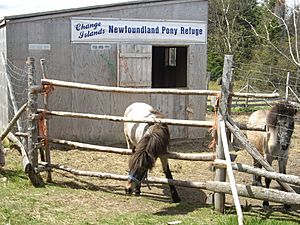Newfoundland pony facts for kids

Newfoundlands in Change Islands
|
|
| Distinguishing features | Sturdy, hardy island pony |
|---|---|
| Country of origin | Canada (Newfoundland) |
| Breed standards | |
| Newfoundland Pony Society | Breed standards |
| Horse (Equus ferus caballus) | |
The Newfoundland pony is a special type of pony that comes from Newfoundland, Canada. These ponies are strong and muscular. They come in many different colors, including a rare white color.
The Newfoundland pony developed from different pony breeds. These breeds were brought to Newfoundland by settlers from England, Ireland, and Scotland over 400 years. The ponies roamed freely at first. They bred together to create the Newfoundland pony we see today.
Settlers used these ponies for many jobs. They were used as work ponies and for other tasks. In the mid-1900s, machines took over many jobs. This, along with slaughter, almost made the ponies disappear.
In 1980, a group formed to help save them. This group created a breed registry to keep track of the ponies. Their numbers slowly grew back, but they are still low. In 1997, the Newfoundland pony became a special heritage breed of Newfoundland and Labrador. This law helps protect them. As of 2013, there are only about 200 to 250 of these ponies left.
Contents
What Makes Newfoundland Ponies Special?
Newfoundland ponies are usually between 11 and 14.2 1.1 hands (5 inches, 13 cm) tall. They weigh from 400 to 800 400 to 800 pounds (180 to 360 kg).
Colors and Markings
Most Newfoundland ponies are black, bay, or brown. You can also see them in roan, chestnut, gray, and dun colors.
Sometimes, you might see a truly white Newfoundland pony. This is very rare in horses. Gray horses are more common. Gray horses are born dark. Their hair turns white as they get older, but their skin stays dark. White horses are born white and have pink skin.
Ponies with pinto color patterns cannot be registered. They have very few white markings. Their coat colors can change a lot between seasons.
Body and Temperament
Their heads are small. They have thick fur on their ears, which are small and pointed. Their bodies are strong and muscular. They have a deep, narrow chest and a short back. Their tails are set low. Their coats and manes are very thick, especially in winter.
To be registered, a Newfoundland pony must have a good nature. They need to be gentle and easy to work with. People often use them as family horses. They are great for pleasure riding and pulling carts. You might also see them at horse shows.
History of the Newfoundland Pony
The first Newfoundland ponies came from the British Isles. Settlers brought them to Newfoundland between 1611 and the mid-1900s. The first ponies were Dartmoor ponies. More ponies came from England, Ireland, and Scotland later. These included breeds like the Connemara, Exmoor, and Highland ponies.
Over time, these different breeds mixed together. This mixing created the Newfoundland pony we know today.
Life in Early Newfoundland
In the past, Newfoundland ponies did many important jobs. They helped with farming and gardens. They hauled kelp from beaches and gathered hay. They also carried wood and provided transportation. These ponies were strong and could handle the harsh weather. By 1935, there were over 9,000 ponies on the island.
Facing Extinction
In the mid-1900s, things changed. More machines were used for work. Also, a rule stopped ponies from roaming freely. This caused their numbers to drop. In the 1970s, many ponies were sent to France for horse meat. This almost made the breed disappear completely.
Saving the Breed
Just before they vanished, people who cared about the ponies formed a group. This was the Newfoundland Pony Society, started in 1980. Their goal was to find the remaining ponies. They wanted to register them and help them breed safely. They found about 300 ponies.
In 1997, the Government of Newfoundland and Labrador passed a law. This law, called the Heritage Animals Act, made the Newfoundland pony the first heritage animal of the province. This law means that anyone wanting to send ponies out of Newfoundland needs a permit. This helps make sure ponies go to safe homes, not slaughterhouses.
There has been a discussion about whether the breed should get federal recognition in Canada. Some people believe the current provincial law offers better protection. The provincial government will make the final decision.
Genetic Studies
Scientists have studied the DNA of Newfoundland ponies. These studies show that the Newfoundland pony is very unique. It has a lot of genetic diversity. This means they have a wide range of genetic traits. This helps confirm their special heritage. To be registered, ponies must have DNA tests. This proves they are true Newfoundland ponies.
Current Status
The Newfoundland pony is still considered critically endangered. This means there are very few of them left in the world. As of 2013, there are only about 200 to 250 breeding ponies. Most of them live in Newfoundland and Labrador and Ontario. Smaller groups live in other parts of Canada and the United States.

